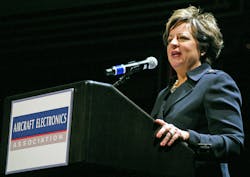An Interview With Paula Derks
Last summer during EAA AirVenture, I had the opportunity to sit down with Paula Derks, the outgoing president of the Aircraft Electronics Association (AEA), shortly after she announced her plan to retire. In October 2018, after a long search AEA’s board of directors selected Mike Adamson as the next president and chief executive officer effective March 25, 2019, effective during the 62nd annual AEA International Convention & Trade Show in Palm Springs, CA.
RD: Paula thank you for taking time and meeting with me today. Describe for our readers the history of AEA.
PD: The organization was formed in 1957. For the first 20 years the association was led by a volunteer staff made up of its members. It was a slow start because it was just shop owners and managers that were trying to meet a couple of times a year to discuss growing the organization.
In 1977, it had grown to the point where we had our monthly magazine plus more work running the association and it was decided AEA needed a full-time paid staff. It was getting too big for volunteers to successfully manage.
My father was hired as the first president in 1977. And then when he announced his retirement in the mid-1990s, I had been working for the association at that point for about 18 years. I started right out of college working on the magazine and worked up to director of communications. When they put the job opening out there, I was one of 11 people who interviewed for the job and the rest is history. I was hired by the AEA board and so I truly am the second president.
RD: During your time at AEA, what's been a couple of the biggest challenges that the electronics or avionics sector has seen?
PD: I would say the biggest challenges in regards to avionics are just keeping up with the rapid introduction of the new technologies. Not that the industry isn't keeping up as far as the brilliant engineers that are designing these avionics, but the regulators. I feel for the regulators trying to keep up with regulating this explosion of new technologies and how to regulate and how to certify the equipment. How to approve the installation, now on a variety of aircraft and across a broad range of aircraft (Parts 23, 25, 27, 29) and making all those avionics applicable to those different segments of aviation. It's still to this day a hard job for the regulators of both FAA and international regulatory bodies to keep up with the new technologies coming out.
Over the last few years, avionics have become more and more like a consumer electronics industry. Avionics are becoming easier to install, easier to use with features like our personal electronics. And they're at a price point now where people can upgrade every few years instead of every 25 years. I don't think they'll ever become disposable. Also, the noncertified market enjoys a little bit more leeway than the certified market does.
RD: With that in mind what would you say about repair of modern avionics?
PD: Bench repair is almost nonexistent anymore as far as modern avionics is concerned. But really, we've seen bench repair slowly going away even in the last 20 years; more rapidly so in the last 10.
About 20 years ago we commissioned a strategic report on the future of repair and overhaul in the industry and new products coming out. The committee was made up of AEA members, both the manufacturers and the repair stations. I remember the outcry from some of the repair station members when that report was released saying, "That cannot be. There will always be repair, that's how we've made our living." The report basically said you'd better start looking for different revenue streams, because with the advancement of modern avionics you're going to be doing software upgrades and replacement of units, and the traditional repair business will eventually go by the wayside. That report was right.
RD: How have your repair station members embraced the new reality?
PD: A lot of them have realized this is the pathway the industry is taking but change is hard. There are those that built their livelihood and business on bench repair. That's what they were known for; experts in the field of troubleshooting, testing, and repairing equipment. As those legacy pieces of equipment age, a lot of the manufacturers cannot afford to support them. For the general aviation industry, they're starting to realize we can't continue to support a 30-year-old piece of equipment; as good as it still may be working.
It's sort of a testament to the industry that they built these long-lasting products, but then it's also a reality that it's 30 years old. It's time to advance to modern avionics if you want to continue to fly in the modern airspace.
RD: Yes, but when you make the comparison between consumer electronics, it's easier to replace your flat screen TV every two years than it is a box on an airplane.
PD: Absolutely. I don't think that it will become that disposable. But you also don't take your TV in for repair or call a washing machine repairman anymore because you know it's going to have a life span now of about 10 years. It is easier just to replace it. But seeing the life in today's modern world of avionics, are we going to expect that brand new flight management system, GPS system, or transponder to last 30 years like we did 30 years ago? I don't think you could say that now. And it's progression, and that's what built our industry as well as enjoying all the capabilities of the new technologies.
RD: What do you have to say about the ADS-B Out mandate?
PD: Everybody asks me or us at AEA what happens on Jan. 2, 2020? Right now, we're so geared toward meeting this mandate, the manufacturers and all the suppliers are busy cranking out equipment, and the shops are busy with installs. They've got backlogs which we haven't seen in years for any of our shops.
RD: And what happens after Jan. 2, 2020?
PD: First of all, I don't believe all owners will meet the mandate, because they've waited too long. They're finding the installation slots are filled. So, I think that throughout 2020 shops will still continue to be busy doing ADS-B installs.
RD: What do you see out there as the next new breakthrough in avionics and electronics?
PD: I wish I had a crystal ball. I think it will just be a continuation of advancements on connectivity. I think more synthetic vision technology and heads up technologies.
RD: AEA, like many other organizations, was involved with the new Part 23, with the hope it will provide the ability to produce certain components and even aircraft a little bit more streamlined.
PD: Yes, AEA was a big part of it and I think we're already seeing the new system work. It was more airframe focused to bring brand new aircraft quicker, flying off the assembly line at lower cost because you wouldn't have all the same certification costs. It’s being pushed more into the avionics industry as well to make it streamlined. It is now standards based through standard bodies instead of all regulatory based.
AEA is hosting technology incubator forums at our headquarters in Kansas City. We had our first one in August 2017 and invited companies that have new products that are not yet certified but not sure where to begin. We brought the appropriate FAA people in and it was a day long forum and each of these companies got to make a short presentation on their idea, or they had a model or prototype of their equipment and then they met with the FAA. We let them set up table top displays and the FAA went around and spoke individually to each of them on ideas and described the pathway they should take. Last year we had more.
RD: Paula would you comment on the whole workforce, recruitment, retention, and training issues facing the industry.
PD: First, my biggest concern is finding those people that want to enter our industry or who would even consider a career both in avionics and in aviation maintenance. You hear over and over the shortage of pilots and finally they're starting to say, hey, don't forget about us. We have to maintain those airplanes for you to put the pilots in. It is a huge issue. I think that one thing maintenance and avionics has going for it, is there seems to be a change in the United States about students choosing a career in the trades and not having to graduate from college or four-year traditional university.
We're also telling our members the days of hiring an experienced avionics technician are over. You can advertise all you want that a minimum of eight years' experience in the industry, you're not going to find it because unemployment is down. I'm glad to say that our shops are recognizing their talent and charging and paying their technicians what they are truly worth for how highly skilled they are. People aren't job hopping like they were and you're going to have to grow your own.
AEA has a large academic membership as well and we encourage our members to form mentorships and partnerships with these schools; all over, not just in the United States. Get to know your local schools and the kinds of programs they have. You're going to have to do on-the-job training and raise your own avionics technicians.
RD: What would you say to hiring companies right now on this topic?
PD: Probably I would say you may need to lower your hiring expectations of finding a maintenance technician, A&P, avionics technician, with multi-years of experience. They are not there anymore. And as much as you may not want to, you are going to have to hire someone right out of school and use on-the-job training, apprenticeships, and mentoring. You get the opportunity to then mold and meld them into what you want that employee to be and how you expect their level of work and skill to be in your shop.
Again, the days of the multi-year experienced avionics and maintenance technician walking into the shop are gone and so is the low pay. You've got to increase your employee compensation plans to attract these technicians or young people because they will be scooped up by other industries.
RD: Thank you very much Paula for your time today and for the decades of passion and dedication you have given to this industry.


